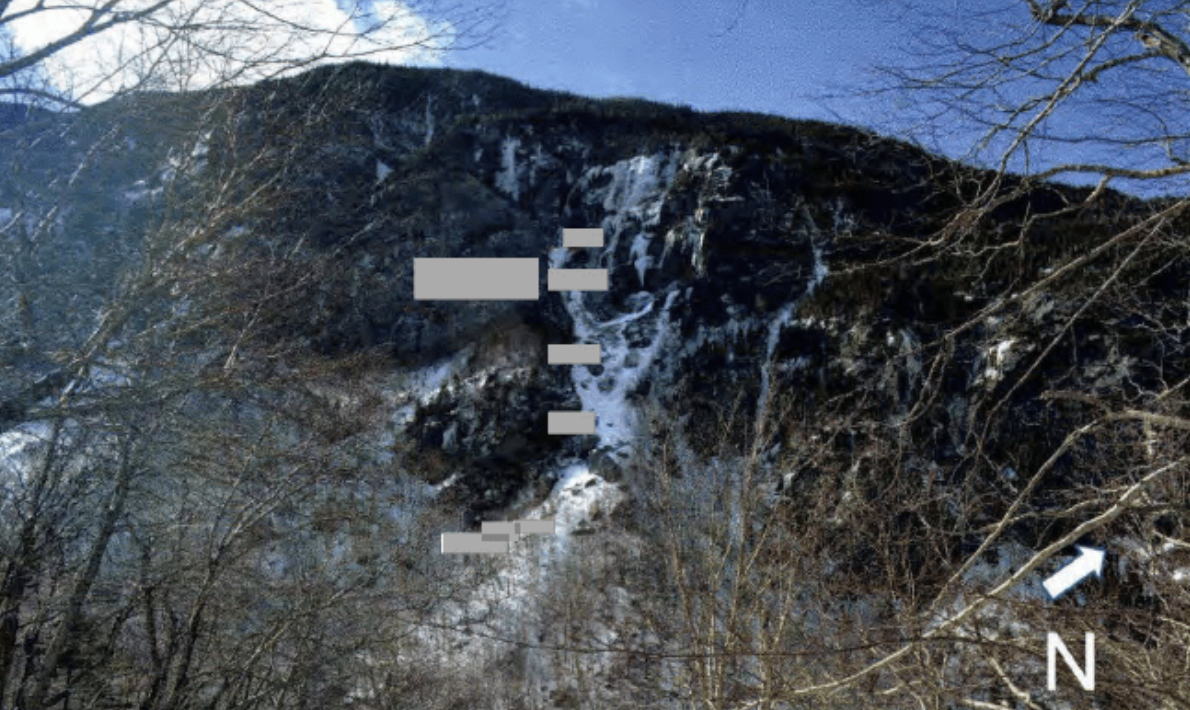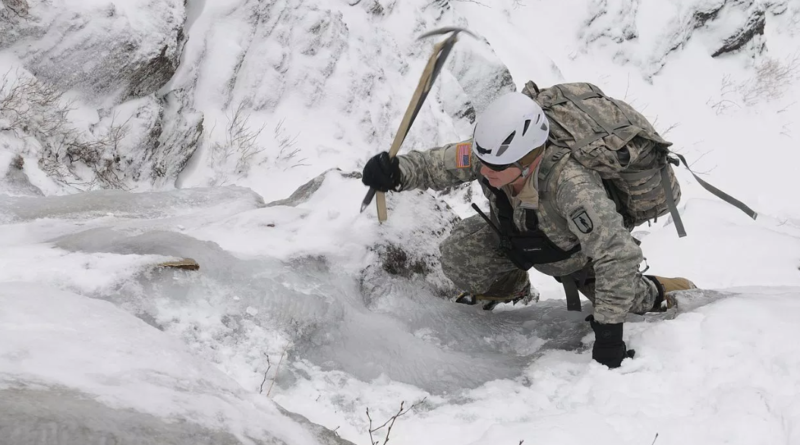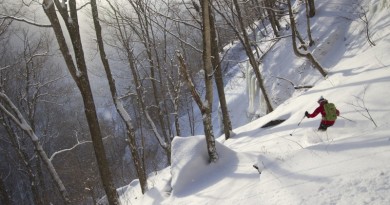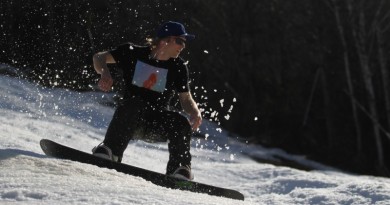Avalanche Report from Smuggler’s Notch Released
By Colin Meyn/VTDigger
The Army Mountain Warfare School did not account for avalanche conditions in its risk assessment process and pushed ahead with training exercises even though some officers and instructors were well aware of the likelihood of a slide, according to an Army accident report on an avalanche that sent five soldiers to the hospital in March.
The report into the Vermont Army National Guard accident at Smugglers Notch in Cambridge was obtained by VTDigger through a Freedom of Information Act request and is heavily redacted. The analysis of what caused the accident, for example, goes on for eight and half pages and is entirely redacted. All names have been redacted throughout the 187-page document.

However, a chronological “history” of the accident and summaries of the interviews with those swept up in the slide or involved in training point to inadequate risk assessment protocols, a lack of preparedness and a failure to respond to conditions on Smugglers Notch before sending a squad of soldiers up a dicey stretch of the mountain without even basic avalanche safety tools.
A non-commissioned officer in the Vermont Army National Guard, who was assistant in charge of the training operations, recounted telling a soldier about the danger on the mountain as he drove him up to the training area.
“He told a student on the drive up that these were some of the most classic avalanche conditions he had ever seen and expect to see a slide,” the interview summary says.

One of the instructors, a sergeant first class with 14 years of service in the military, said that if he were climbing the mountain on a day off, he probably would not have continued up the mountain given the conditions.
“He reported that despite observations that supported an avalanche risk, they continued up the mountain by either rationalizing what they were seeing or not taking the time to process it,” the summary of his interview says.
The officer in charge of safety and risk management, also a sergeant first class, is certified by the American Institute for Avalanche Research and Education and considered himself the “unofficial” avalanche expert at the warfare school, according to his interview.
“SFC shared his belief that the decision to be training in Easy Gully was his job and his responsibility and this accident fully rested on his shoulders,” the summary said of the officer in charge. “He felt his being overconfident in his avalanche mitigation contributed to the accident.”
Although officers personally realized the presence of avalanche conditions, the possibility of an avalanche was not even part of the deliberate risk assessment worksheet that was regularly filled out by officers in charge of the training, according to the Army report.
The commander of the school, Matthew Brown (referred to as LTC, or lieutenant colonel, in the report), said in his interview that he had not received any information about an avalanche risk from those under him on the day of the accident.
“Additionally, an avalanche risk was not on the deliberate risk assessment worksheet because ‘we haven’t had those conditions in any recent memory,’” Brown’s interview summary says.
Brown said at a press conference two days after the accident that the Guard had assessed the avalanche risk “from the road” before sending soldiers into Easy Gully, according to an article in the Burlington Free Press.
In the Army’s accident report, the major who headed the training operation says that he and Brown did briefly speak about an avalanche threat.
“The only conversation about avalanche that he could recall was a brief conversation he had with the commander after cadre and students all departed for the training area,” his interview summary says.

through a ravine at Smugglers Notch in February 2013. The two-week course is taught by the
Vermont National Guard. U.S. Army photo by 1st Lt. Jeffrey Rivard
Mikel Arcovitch, a first lieutenant in charge of public affairs for the Vermont National Guard, did not return a call Tuesday afternoon seeking additional comment on the report.
The Army report says that Brown identified problems with the course risk assessments for the school’s Advanced Military Mountaineer Course and the Basic Military Mountaineer Course in January 2018.
“The AMWS was in the process of making improvements to its RM [risk management] procedures when the accident occurred,” his interview summary said.
A narrative of events leading up to the avalanche said there had been internal resistance to changing the risk assessment procedures, though it’s not clear who was resisting, or what changes were being discussed.
“While some changes on the deliberate risk assessment worksheets (DRAWs) were implemented, the officers were met with resistance from the AMWS cadre to make more significant changes,” the report said.
A couple weeks ahead of the training, Brown communicated the possibility of canceling the training courses, scheduled to begin on March 3, due to warm weather and a lack of winter conditions. But then two nor’easters swept through Vermont and dropped “large amounts of snowfall prior to the accident.”

On March 12, two days before the accident, the chief instructor for the course identified a “weak layer” in the snowpack, the report says, and the next day began avalanche mitigation efforts with an assistant instructor.
“Avalanche mitigation included breaking the weak layer and knocking down snow from areas above Easy Gulley that have been known to trigger slides in the past,” it says.
One of the instructors involved in these risk mitigation efforts notes in his interview that while breaking a path, “he didn’t see any conditions that caused him have ‘warning flags or alarm bells going off.’”
On the morning of March 14, Guard members in the advanced and basic mountaineering courses headed to different locations in the gully, but some of them took longer than expected.
“Due to the late arrival of the BMMC [Basic Military Mountaineer Course] personnel,” the report says, “a typical morning meeting to discuss the day’s activities, mountain conditions, safety, etc. between AMMC cadre, BMMC cadre and training division leadership was not conducted.”
The basic trainees arrived at the school’s “stone hut” at about noon and began setting up their tents, as the advanced trainees started to make their way up the mountain toward a rope that had been installed to help their climb.
“At 1305 as the AMMC squad approached the fixed rope section of Easy Gulley an avalanche engulfs the squad,” the report says.
None of the squad members were carrying a beacon, shovel or probe, all basic avalanche safety tools. But they were all wearing a helmet, goggles, gloves and mountain boots, according to accident checklists.
Five of the six members of the squad were injured, though none were buried in the slide. Two students traveled approximately 500 feet over large rocks. Three others traveled approximately 1,000 feet, and fell 50 feet off a large rock during the descent, the report says.
Guard members sustained injuries including fractures, contusions and abrasions. At least one helmet was significantly damaged, however there were no serious head injuries. The specific descriptions of the injuries are largely redacted from the report.
The rescue effort quickly commenced after the avalanche, with the soldiers swept up in the avalanche establishing communication with those in the stone hut and assessing the damage as local rescue departments responded to a 911 call from the officer in charge.
The last injured Guard member was sent off to the University of Vermont Medical Center one hour and 40 minutes after the avalanche struck.
While at least one officer said in the report that he felt unprepared for the disaster, the Army concluded that the evacuation and rescue operation went off largely without a hitch.
“The rescue operations … was greatly impacted by the fact that the AMWS has conducted annual rescue training at smuggler’s notch for at least the past 11 years,” the report said. “Each of the cadre knew their responsibilities during the rescue and performed their duties.”





Thanks